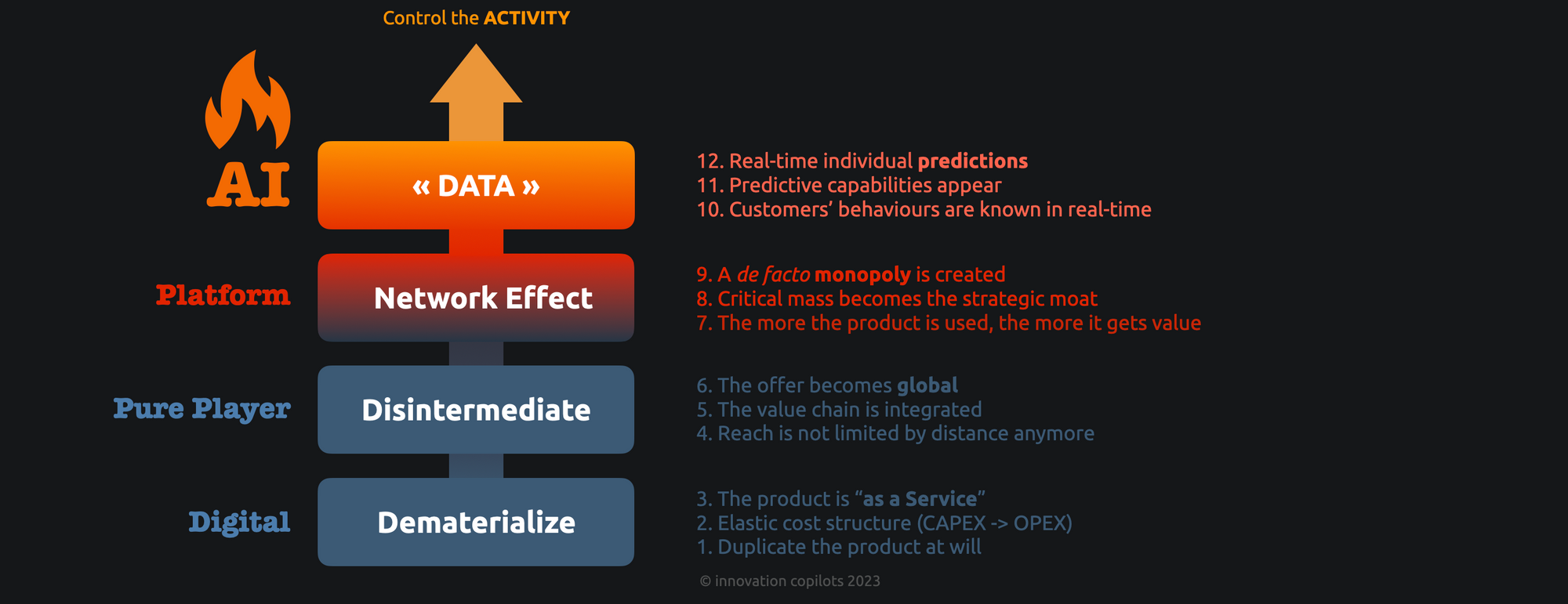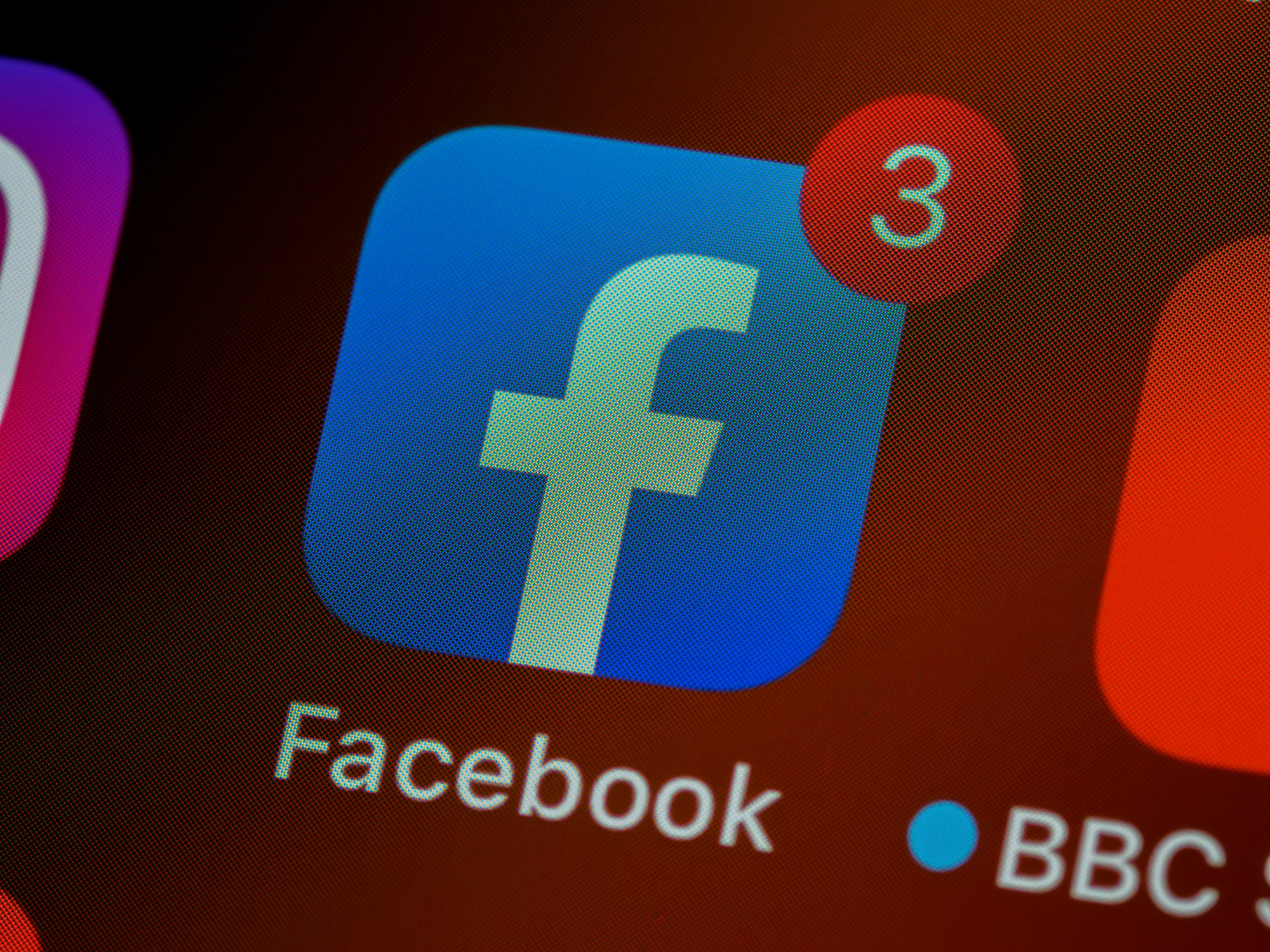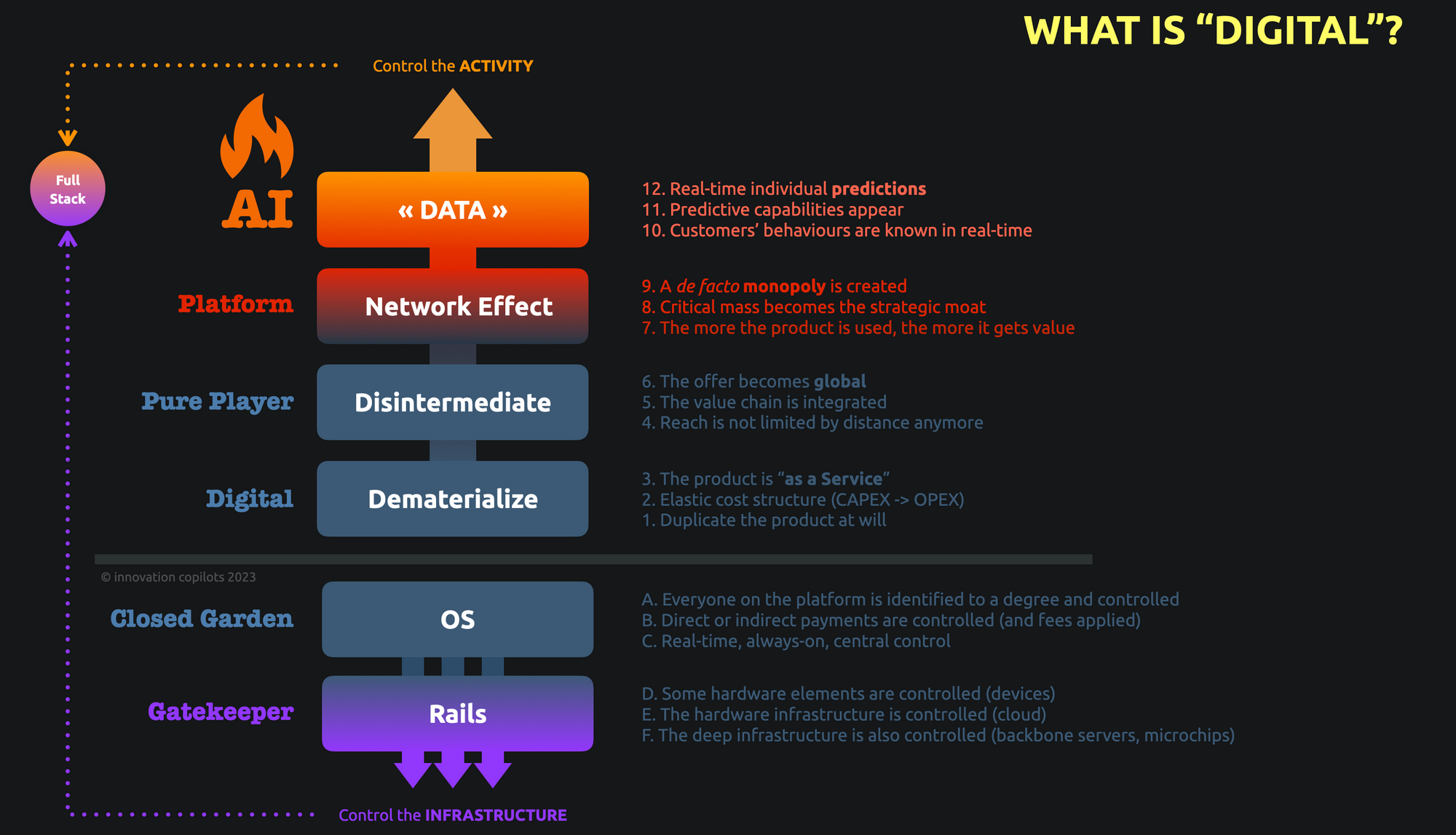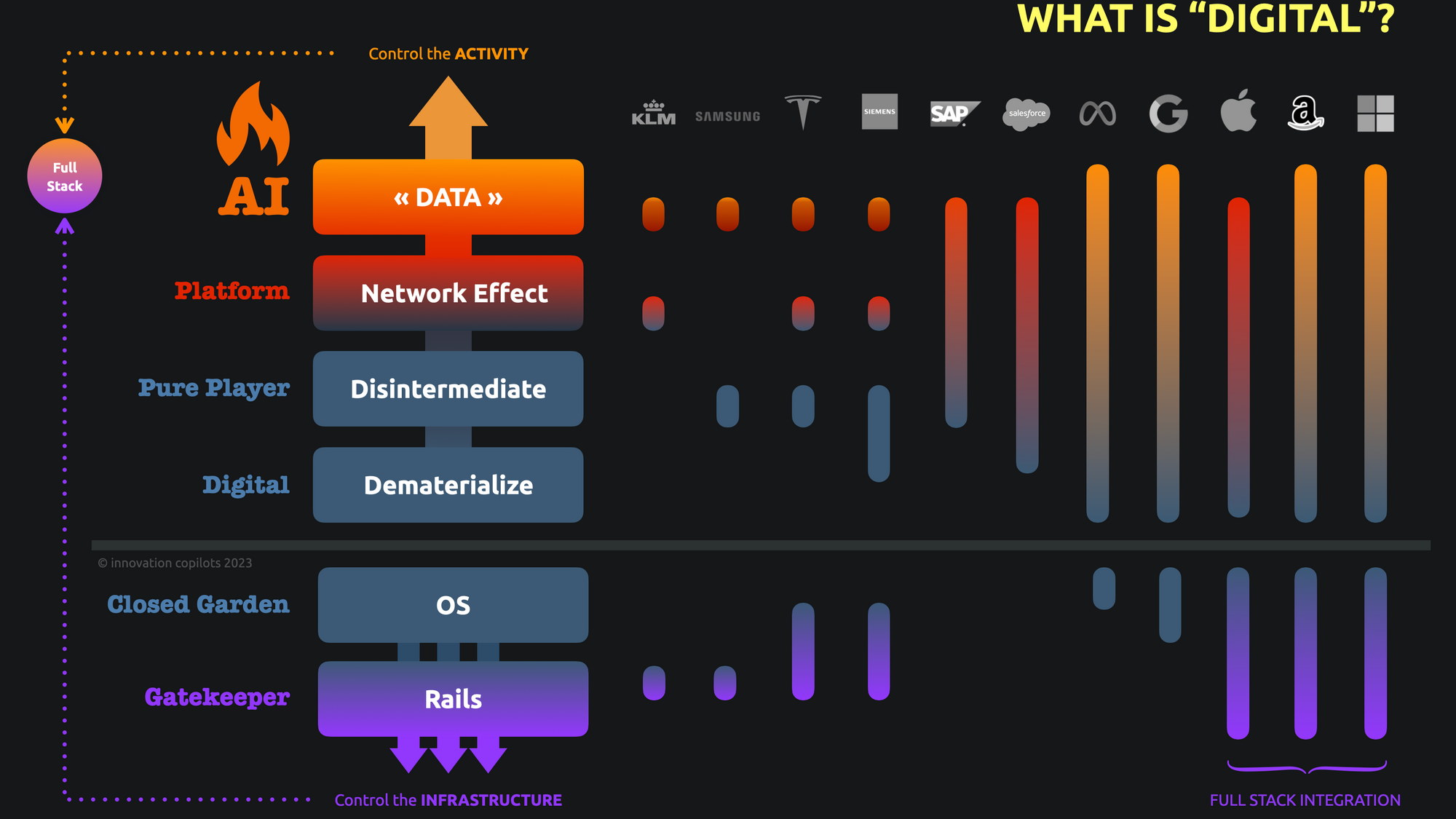🟢 Fifty shades of digital
Digital, digital, digital! For most, it seems to be black magic, or worse, a concept so simple that everyone gets it now! Well, it's neither (even if I'm not entirely sure about black magic). Let me share a framework on 'what is digital' that I've been refining for a few years...

I already gave a few pointers on making sense of digital businesses, but I realize I never went into a full-on explanation. I am also pretty much puzzled on a daily basis by how very few practical explanations have been given about what is "digital."
Wikipedia, which always gives the well averaged-out definition possible of anything, just says:
The digital economy is a portmanteau of digital computing and economy, and is an umbrella term that describes how traditional brick-and-mortar economic activities (production, distribution, trade) are being transformed by Internet, World Wide Web, and blockchain technologies.
Which could be summarized as "businesses with connected computers." (Don't sweat too much on the b_chain word, as it's just a residual artifact of the most painful and irrelevant tech hype we have had these last years.)
There is also the seminal 1995 quote from Nicholas Negroponte:
When information is embodied in atoms, there is a need for all sorts of industrial-age means and huge corporations for delivery. But suddenly, when the focus shifts to bits, the traditional big guys are no longer needed. Do-it-yourself publishing on the Internet makes sense. It does not for a paper copy.
Or, because it's 2023, we can ask ChatGPT:
- Philippe: define what is digital
- ChatGPT: Digital refers to the use of electronic devices, systems, or technology that operate by processing and transmitting data in a numerical form, typically using binary code (1s and 0s). Digital technology encompasses a wide range of applications, including computers, smartphones, tablets, digital cameras, digital televisions, and more. It enables the creation, storage, manipulation, and sharing of data and information in a digital format, which can be accessed, transmitted, and processed using digital devices and networks. Digital technology has transformed many aspects of modern life, from communication and entertainment to business and education, and continues to evolve and shape the way we live and work.
But essentially, if you want to have a structured approach to what is digital, you're definitively on your own.
So, let me help.
Controlling the activity
If we look at digital through the lens of business, there is the first simple, key notion of "going online." It's about how a business can evolve from a brick-and-mortar logic to become more dematerialized, extend its reach and maybe even leverage new opportunities to build a dominant position.
This can be precisely boiled down to four transformational concepts that work together in a cascading way when your product becomes more and more code rather than atoms in a physical box:
- Dematerialize (duplicate the product at will, then move into an elastic cost structure, then the product is “as a Service.”)
- Disintermediate (distribution reach is not limited by distance anymore, the value chain becomes integrated, and finally, the offer becomes global.)
- Network effects kick in (and that's the big one when more customers attract more customers, then their critical mass becomes the main strategic moat, and eventually, a de facto monopoly is created.)
- "DATA" (customers' behaviours are known in real-time, Predictive capabilities appear, and someday individual predictions in real-time become possible too.)
The end game is full predictive control of anything flowing throughout your business:

Another way to present this is to say that businesses stepping into the digital world will always start by dematerializing a physical product (AirBnB and the proverbial hotel room), then become more and more capable of serving customers wherever they are (streaming mp3 instead of shipping CDs), can create a network effect (the more you use Apple products, the more incentive your family has to do the same), and eventually build enough data to understand what their customers want (Amazon). In passing, these notions also define what a pure player is, what a platform is, and why AI is so important.
If you need a reminder of what is a network effect and why it's such a critical step; here's a refresher:

Through all this, remember that digital businesses always strive to remove as much friction as possible from everything they do. Single-step authentication, once-click payments, easy and comprehensive search tools, absence of lag or delay to access any step, etc.

When you understand these first four concepts (plus friction removal), you can already benchmark any business by asking how digital it is and checking its level of dematerialization, disintermediation, the presence of a network effect, and possibly, the way it leverages data to understand and predict its own market.
But let's push further...
Controlling the infrastructure
The other part of "what is digital" is the underlying chrome.
The critical role of the hardware layers running digital activities is often forgotten from a business perspective. It's a major error, as it really unlocks the second (and mostly end-game) layers of competitive advantages. We can summarize this vastly complex part with two simple questions: who runs the underlying operating system (OS) for these activities, and who owns the physical "rails" on which the OS operates and all activities depend on?
Which leads to the other shades of digital:
- OS (Everyone on the platform is identified to a degree and controlled, then direct or indirect payments are controlled, and lastly, real-time, always-on, central control is secured.)
- Rails (Some hardware elements are more and more controlled, from the devices to the cloud and, eventually, the backbone physical infrastructure.)

Here again, this gives you the key questions to ask further to benchmark the level of digital supremacy a business might have reached or understand what really is a gatekeeper (AWS) or a closed garden (Apple Store) in this context.
A dual push to control activity and infrastructure
As you anticipated, the full picture of what is digital is still somehow complex when you dive into the details. Still, if you squint your eyes, it's about pushing in two directions: controlling the activities and controlling the infrastructure.

This, in turn, can allow you to have on-point and much clearer discussions on which business model is more efficient at digital or, more prosaically, why Sony or Samsung are not even competing in the slightest with Apple (they only sell devices, whereas Apple is a full-stack ecosystem).
The different shades of digital
Now, obviously, this framework cannot perfectly describe all the nuances and shades of digital businesses. Its goal is to allow you to get these nuances and rapidly discriminate between different approaches and commitments to being digital.
It also offers simple explanations as to why efficient pure players like SAP or Salesforce will never be able to beat Microsoft in B2B, why Tesla is indeed a digital business with network effects, why Meta and Google will never be the most powerful in the GAFAM club, or why digital underdogs like Siemens might be building a significant competitive advantage as we speak:

In conclusion
As always, I try to remind everyone that I'm not in the business of having the definitive word or theory on X. What matters to me is developing actionable insights fast and efficiently. In that context, it's all about taking the right shortcuts and lowering the overall complexity of a given business field with proper concepts and identifiable milestones.
I've been working (and adjusting) the above framework for over five years. Although I tested it with many customers, from startup founders to industry executives, there is certainly room for improvement. If you have ideas (ideally on simplifying it even further), get in touch, I'd love to get your perspective.
Oh, and let's not forget: this framework and other tools we are using in our daily consulting practice are available as online training programs for your teams if you ever need them 😘






